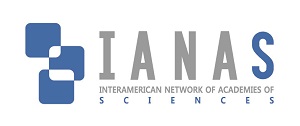Lead Academy : Academia nacional de Ciencias exactas, fisicas y naturales (Argentina)
Chair (2012-2014): Prof. Norma Nudelman (Argentina)
The Inter-American Network of Academies of Sciences (IANAS) is a network of 19 American Academies of Science (from Canada to Argentine) created in 2004 to strengthen the capacity and promoting the role of academies of sciences as instruments for advancing knowledge creation, prosperity and equity in the Americas. IANAS comprises five programs, among them the IANAS Science Education Program (IANAS SEP) constitutes the main and more developed program of science education in the Hemisphere. The goal of IANAS SEP is to improve sci ence education in the Americas through the active participation of Science Academies, by engaging in working together with teachers, educational authorities, decision-makers, industrial leaders, etc.
ence education in the Americas through the active participation of Science Academies, by engaging in working together with teachers, educational authorities, decision-makers, industrial leaders, etc.
The IANAS SEP focuses on improving science education in schools, as science education in the school is the primary route for children to learn about science, its values, concepts and objectives. The school is also where young people begin to understand the importance of scientific exploration for their cultural and skills development and for their socioeconomic promotion. The initial focus of the IANAS SEP program was on implementing the Inquired Based Science Education (IBSE) methodology in elementary level science education. Additionally, important programs on secondary and tertiary science education have recently been developed by some Academies at national level, and the first Latin American Workshop on IBSE in secondary education was held in 2009.
The IANAS SEP Council is constituted by all Focal Points, and one of the main strengths of the Program is the annual Focal Point’s meetings, where the members have opportunities of sharing materials and experiences, generate common methods, etc. Meetings have been held since 2004. With high respect for the local cultures, circumstances, and priorities, different approaches have been applied: Academies have either focused on working directly with students in schools, or they have worked to train primary, mid and high school teachers. An Inter-American Strategic Planning Workshop held in Argentina in November 2011 established the Strengths, Weakness, Opportunities and Threats of IANAS SEP defined the 5 Top Areas to work in for the next 5 years and constituted 5 Committees to carried out the different activities.
Some activities sponsored by IANAS SEP in 2012 include:
- Courses on Molecular Biology and Genomics for Biology Teachers in Secondary Education, started in Jan 2012 with a Pilot Course in Chile, followed by 3 Theoretical –Practical Courses in Costa Rica, Mexico, and Chile (Nov. 2012). The courses were mainly sponsored by the Wellcome Trust Fundation.
- Distance Seminars with teachers of 7 Central America countries to establish the program " La Ciencia en tu Escuela ", an in-service teachers’ training program coordinated and sponsored by the Mexican Academy of Sciences, for training in Mathematics, Natural Sciences, and Development of communicative skills.
- IX IANAS SEP Focal Points meeting held in Bogotá (Colombia) in August 2012. The IANAS SEP Strategic Planning was refined and updated, Focal Points briefly commented on their national activities, and materials for science education were distributed. The new Chair and Vice-Chair for the next 3 year period were elected
- As a result of the network’s activities, a forum “Indagala” was created for discussion and evaluations. In 2012 the Science Education Portal “Indagala” was re-organized with new content based on the experience of IANAS Academies and IBSE didactic modules provided by the Focal Points. www.indagala.org
- IBSE Workshop for primary school teachers of “English-speaking” Caribbean countries, organized by the Caribbean Academy of Sciences.
- IV Latin American theoretical-practical Course on GREEN CHEMISTRY for secondary school teachers applying IBSE methodology, in Santa Fe (Argentine) November 2012. Jointly sponsored by the Secretariat of Science and Technology (Province of Santa Fe, Argentina)